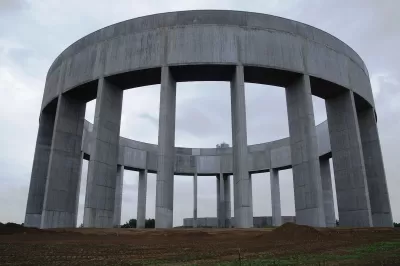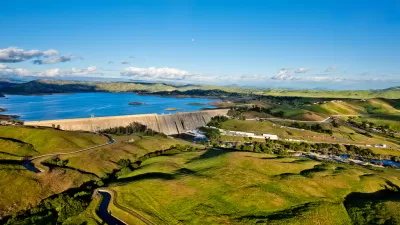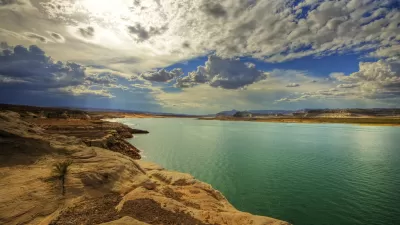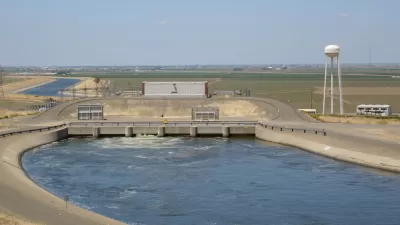Swedish cities are encouraging designers to dramatically reimagine the humble water tower.

A recent trend in Sweden is replacing the country’s aging water towers with radically different designs akin to Modernist architecture. As Nate Berg explains in Fast Company, the trend began in Varberg, where the city held a design competition for a new water tower when the city’s old water system sprang a leak.
Cast in stark concrete and perched atop a small hill, the water tower has the unusual form of a long and narrow rectangle propped up on nine slender pillars. Scalloped along its lengths with subtle curves that recall waves of the nearby coast, the water tower is a radical departure from the bulbous and cylindrical tanks found in cities around the world.
While water tower design is largely dictated by utility — stipulations for the contest included water capacity and safety considerations — the competition called for a design that would become a local landmark that communicates “creativity, slenderness, comfort, and strength.”
The unique Varberg tower sparked a rash of other design contests around the country as cities replace old water towers and build new ones to accommodate population growth. “Advanced design tools and hydrological modeling software are now making it possible for the design of these water towers to take inventive new forms. One new water tower, built in the city of Helsingborg, is shaped like a large floating ring.”
FULL STORY: Sweden just turned the humble water tower into art

Alabama: Trump Terminates Settlements for Black Communities Harmed By Raw Sewage
Trump deemed the landmark civil rights agreement “illegal DEI and environmental justice policy.”

Planetizen Federal Action Tracker
A weekly monitor of how Trump’s orders and actions are impacting planners and planning in America.

The 120 Year Old Tiny Home Villages That Sheltered San Francisco’s Earthquake Refugees
More than a century ago, San Francisco mobilized to house thousands of residents displaced by the 1906 earthquake. Could their strategy offer a model for the present?

LA’s Tree Emergency Goes Beyond Vandalism
After a vandal destroyed dozens of downtown LA trees, Mayor Karen Bass vowed to replace them. Days later, she slashed the city’s tree budget.

Sacramento Leads Nation With Bus-Mounted Bike Lane Enforcement Cameras
The city is the first to use its bus-mounted traffic enforcement system to cite drivers who park or drive in bike lanes.

Seattle Voters Approve Social Housing Referendum
Voters approved a corporate tax to fund the city’s housing authority despite an opposition campaign funded by Amazon and Microsoft.
Urban Design for Planners 1: Software Tools
This six-course series explores essential urban design concepts using open source software and equips planners with the tools they need to participate fully in the urban design process.
Planning for Universal Design
Learn the tools for implementing Universal Design in planning regulations.
Ada County Highway District
Clanton & Associates, Inc.
Jessamine County Fiscal Court
Institute for Housing and Urban Development Studies (IHS)
City of Grandview
Harvard GSD Executive Education
Toledo-Lucas County Plan Commissions
Salt Lake City
NYU Wagner Graduate School of Public Service





























